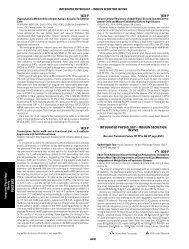Dominant-Negative Effects of a Novel Mutated Ins2 Allele Causes ...
Dominant-Negative Effects of a Novel Mutated Ins2 Allele Causes ...
Dominant-Negative Effects of a Novel Mutated Ins2 Allele Causes ...
You also want an ePaper? Increase the reach of your titles
YUMPU automatically turns print PDFs into web optimized ePapers that Google loves.
FIG. 4. Serum insulin levels 10 min after glucose challenge (A), HOMA<br />
<strong>of</strong> �-cell index (B), insulin tolerance test (C), and HOMA <strong>of</strong> insulin<br />
resistance (IR) index (D) at 1, 3, and 6 months <strong>of</strong> age. Serum insulin<br />
levels (A) and HOMA <strong>of</strong> �-cell indices (B) <strong>of</strong> Munich <strong>Ins2</strong> C95S mutant<br />
(mt) mice are significantly lower than those <strong>of</strong> wild-type (wt) mice. C:<br />
Blood glucose decrease from basal is significantly less in mutants<br />
versus wild-type mice. D: One-month-old female (f) mutants and 3- and<br />
N. HERBACH AND ASSOCIATES<br />
Insulin tolerance tests were performed in 4-month-old<br />
male mice. The decrease in blood glucose levels from<br />
basal to 10 min after insulin injection was significantly<br />
smaller in Munich <strong>Ins2</strong> C95S mutants than in wild-type<br />
mice. The further decrease <strong>of</strong> blood glucose was nearly<br />
identical in mutants and wild-type mice (Fig. 4C). The<br />
HOMA <strong>of</strong> insulin resistance was significantly higher in<br />
1-month-old female mutants and in 3- and 6-month-old<br />
male mutants (Fig. 4D). Pancreatic insulin content was<br />
significantly reduced in both male and female Munich<br />
<strong>Ins2</strong> C95S mutant mice, irrespective <strong>of</strong> the age at sampling<br />
(Fig. 5).<br />
Homozygous mutant mice. Homozygous mutant mice<br />
were born at the expected Mendelian frequency and<br />
developed normally until 18 days <strong>of</strong> age. As evidenced by<br />
glucosuria, diabetes occurred at this time point. At 21 days<br />
<strong>of</strong> age, blood glucose levels were largely increased in both<br />
male (n � 14) and female (n � 9) mutants compared with<br />
wild-type mice (male 400 � 123 vs. 111 � 17 mg/dl and<br />
female 394 � 150 vs. 107 � 6 mg/dl). The body weight <strong>of</strong><br />
homozygous mutants was significantly reduced at 28 days<br />
<strong>of</strong> age compared with wild-type mice (male 11 � 2 vs. 17 �<br />
2 g and female 10 � 4 vs. 15 � 2 g). Homozygous male (n �<br />
14) and female (n � 9) mutants died at a mean age <strong>of</strong> 46<br />
days (range 31–76) and 52 days (33–75), weighing 9 � 2<br />
and 7 � 1 g, respectively.<br />
Immunohistochemical and quantitative stereological<br />
investigations <strong>of</strong> the endocrine pancreas. At 6 months<br />
<strong>of</strong> age, the pancreas volume (V pan) (Fig. 6A), as well as<br />
gross morphology and histologic appearance <strong>of</strong> the exocrine<br />
pancreas, were unchanged in Munich <strong>Ins2</strong> C95S mutant<br />
mice, and no signs <strong>of</strong> insulitis were observed.<br />
Immunohistochemistry for insulin and glucagon revealed<br />
an atypical composition and organization <strong>of</strong> islets <strong>of</strong><br />
Munich <strong>Ins2</strong> C95S mutants. Very few islet cells stained<br />
insulin positive, and the staining intensity was very weak,<br />
whereas the proportion <strong>of</strong> cells expressing glucagon was<br />
increased. �-Cells were dispersed over the islet pr<strong>of</strong>ile in<br />
mutant mice, which was markedly different from the<br />
typical distribution <strong>of</strong> endocrine cells in murine pancreatic<br />
islets, being characterized by a ring <strong>of</strong> non–�-cells surrounding<br />
a core <strong>of</strong> �-cells (Fig. 5A–D).<br />
The total islet volume <strong>of</strong> Munich <strong>Ins2</strong> C95S mutant male<br />
mice was significantly lower than that <strong>of</strong> wild-type mice<br />
(Fig. 6B). Due to the weak insulin-staining intensity <strong>of</strong><br />
�-cells, the measurement <strong>of</strong> the insulin-positive area resulted<br />
in an underestimation <strong>of</strong> the total �-cell volume and<br />
the volume density <strong>of</strong> �-cells in the islets (data not shown).<br />
Therefore, the total �-cell volume was calculated by<br />
subtracting the total volumes <strong>of</strong> �-, �-, and PP-cells from<br />
the total islet volume. The calculated total �-cell volume<br />
was decreased by 81% in Munich <strong>Ins2</strong> C95S mutant males<br />
(P � 0.001) and by 19% in females (P � NS) compared with<br />
sex-matched wild-type mice (Fig. 6D). The calculated<br />
volume density <strong>of</strong> �-cells <strong>of</strong> mutant males was also significantly<br />
lower compared with male wild-type mice; the<br />
difference in the total �-cell volume and the volume<br />
density <strong>of</strong> �-cells in the islets <strong>of</strong> female mutants versus<br />
wild-type mice did not reach statistical significance (Fig.<br />
6C).<br />
Volume densities <strong>of</strong> �-, �-, and PP-cells in the islets, as<br />
well as the total volumes <strong>of</strong> �- and PP-cells, were signifi-<br />
6-month-old male (m) mutants show significantly higher HOMA <strong>of</strong><br />
insulin resistance indices than wild-type mice. Data represent means<br />
and SE. *P < 0.05.<br />
DIABETES, VOL. 56, MAY 2007 1271
















